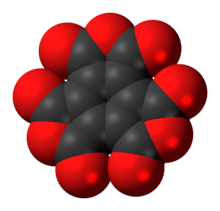Mellitic anhydride

| |

| |
| Names | |
|---|---|
| Preferred IUPAC name
Benzo[1,2-c:3,4-c′:5,6-c′′]trifuran-1,3,4,6,7,9-hexone | |
| Identifiers | |
3D model (
JSmol ) |
|
| ChemSpider | |
PubChem CID
|
|
| UNII | |
CompTox Dashboard (EPA)
|
|
| |
| |
| Properties | |
| C12O9 | |
| Molar mass | 288.123 g·mol−1 |
| Appearance | colorless solid[1] |
| Melting point | 161 °C; 322 °F; 434 K[1] |
| Vapor pressure | 0.000004 mmHg (20°C)[1] |
| Hazards | |
| NIOSH (US health exposure limits): | |
PEL (Permissible)
|
none[1] |
REL (Recommended)
|
TWA 0.005 ppm (0.04 mg/m3) Should be handled in the workplace as an extremely toxic substance.[1] |
IDLH (Immediate danger) |
N.D.[1] |
Except where otherwise noted, data are given for materials in their standard state (at 25 °C [77 °F], 100 kPa).
| |
Mellitic anhydride, the anhydride of mellitic acid, is an organic compound with the formula C12O9.
Containing no other elements (e.g., hydrogen) besides carbon and oxygen, mellitic anhydride is an
Justus Liebig and Friedrich Wöhler in 1830 in their study of mellite ("honey stone") and has the empirical formula C4O3.[2][3][4] The substance was properly characterized in 1913 by H. Meyer and K. Steiner.[5][6] It retains the aromatic character of the benzene ring.[7][8]
References
